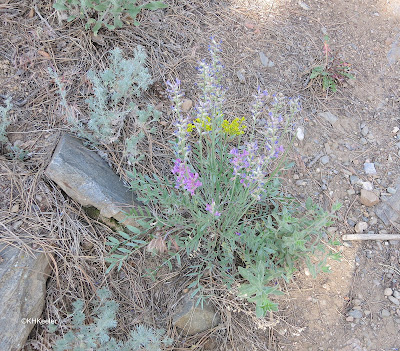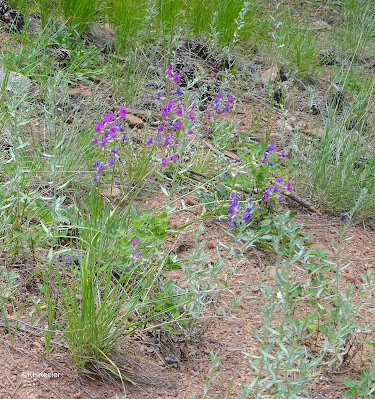That flash of magenta in the meadow
A closer loook shows its a legume, pea family, Fabaceae. In the Colorado Front Range, only locoweeds, milk vetches and vetches are that color. The vetches, genus Vicia, are small and vining, with tendrils. That's not what I have here.
The locoweeds, genus Oxytropis, and the milk vetches, also called locoweeds, genus Astragalus, are quite similar. Locoweeds have flowers with pointed tips on the central fused petals (keel), pointed leaves, and virtually no stems. Milkvetches have blunt keels, less pointy leaves, hairy leaves and stems and leaves on flower stems.
I admit I rarely tried to key these, thinking them all locoweeds. When I searched on the internet for locoweeds, I came up with both genera, Oxytropis and Astragalus. Often when that happens, I think someone is confused, but in this case, the two genera have the same poisons, so both are locoweeds. Eating too much of either, cattle become disoriented and stagger, acting "loco" (crazy, from Spanish.)
Horses, cattle, sheep, goats, deer, elk, and pronghorn, dogs, people and more can be poisoned by locoweeds. All parts of the plants are toxic even when dry. Animals that graze steadily on feed containing locoweeds show symptoms of poisoning, called locoism, within two weeks. Poisoned animals show neurological damage, weight loss, infertility and birth defects, and, in the extreme, die. The characteristic loss of coordination led to the word "loco" which became the plants' common name.
The scientific name, Oxytropis is from the Greek oxyx, sharp, and tropis, keel, referring to the flower. Astragalus is an ankle bone in Greek, apparently the root looks something like that. Both are huge genera, found across North America and Eurasia, 526 and more than 3,000 species respectively. North America has 25 species of Oxytropis, mainly in the north and west, and 353 species of Astragalus, also mainly in the north and west.
I'm talking here mostly about purple locoweeds, especially purple locoweed or Colorado locoweed Oxytropis lambertii, and purple-flowered Astragalus species such as purple milk vetch, Astragalus agrestris and prairie milk vetch Astragalus laxmanii, because of their easily recognized flowers, but both genera of locoweed have white and pink-flowered species. Whether all species of both genera are equally poisonous nobody knows; that's a huge project.
The tale of these two poisonous plant genera is complicated by the fact both Oxytropis and Astragalus contain swainsonine, a poisonous alkaloid, and both concentrate selenium, an essential element that is toxic if consumed in excess, which accumulates in their tissues when it is abundant in the soil.
Swainsonine occurs in a number of plants scattered across the plant kingdom. It is an alkaloid that disrupts metabolism, leading to a chronic wasting disease in livestock characterized by "weight loss, depression, altered behavior, decreased libido, infertility, and death" (quoting Cook, Gardner and Pfister in 2014). Selenium is a non-metallic element found in soils, especially in dry regions of the world. Animals, including humans. require trace amounts of selenium, but larger doses cause symptoms such "hair loss of the mane and tail, cracking of the hooves, and often signs of lameness, excess salivation, and respiratory failure. Severe overdose of selenium can lead to death." (quoting House, 2016). Substitute hair and nails for mane and hooves for humans. In humans, bad breath is a sign of selenium poisoning, generally described as "garlic breath." Reading the symptoms, the "loco" behavior is probably due to swainsonine. However, much of the literature seems unaware that there are two toxins in these plants and makes blanket assertions about the symptoms for one or the other, so it is hard to be sure.
In Colorado and the west, where Oxytropis and Astragalus are common and abundant, selenium is often found in the soils. So while consuming locoweeds does not necessarily give you a dangerous dose of selenium, it probably will. (Map of selenium in North America link).
Swainsonine is quite toxic, but I cannot find a report of human poisoning. I think that is because people rarely eat locoweeds or the other plants that contain it, such as the darling pea (Swainsonia canescens) of Australia. Selenium, however, in 2006 killed a man who took excessive amounts of a selenium dietary supplement, and in 2008-9 over use of supplements made some 201 people in the U.S. sick, only one of which was hospitalized. Across the drier areas of the world, human poisoning from selenium-concentrating plants is an ongoing problem.
 |
|
Many toxic plants taste bad, often very bitter, so livestock do not eat them if they have other choices. Apparently the locoweeds taste okay to cattle, rather like alfalfa (Medicago), and so they don't avoid them; indeed, older animals teach younger ones that locoweeds are safe to eat. There is no easy treatment for poisoning so prevention is recommended. Animals should be kept on land with lots of safe forage, so that locoweeds are a tiny part of the diet. For greater protection, pregnant and lactating animals should be moved to truly locoweed-free pastures; non-reproducing are less sensitive to the poisons.
This story took a new turn recently. Researchers determined that swainsonine is not synthesized by plants, but rather, by fungi that live inside plant tissues. The fungi are passed on in the seeds to the next plant generation. This appears to apply to all the scattered plants with swainsonine (Astragalus, Oxytropis, and Swainsonia in the pea family Fabaceae; species in two genera of morning glories (in the Convolvulaceae), and a mallow (Sida, hibiscus family, Malvaceae).
Why are the locoweeds so toxic? Why two poisons?
Probably the double protection works to reduce animals eating them. Lots of natural systems are shaped by herbivores; they eat the nontoxic, non spiny plants and leave the others behind. Herbivores range from moose and elk to rabbits to beetles and butterfly larvae, to fungi, bacteria, and viruses. No one chemical will protect from all of those. The large number of species in both Oxytropis and Astragalus result from rapid diversification in the recent past; perhaps swainsonine and selenium are part of their success story. The fungus must have colonized long ago, maybe as a disease of the locoweeds' ancestors, but, by being toxic, it conferred protection from animals, so a positive relationship evolved, the plant hosting the fungus, the fungus producing swainsonine throughout the plant. Concentration of elements like selenium probably reflects the inability of the plant to be rid of selenium; it takes up the element and then is stuck with it for the rest of its life. But if containing high amounts of selenium at same time discourages herbivores, that makes a burden into a benefit to the plant, and aided their survival.
These are attractive native wildflowers, well protected by containing two poisons. Admire them and don't eat them.
 |
| locoweeds below a shrub |
Comments and corrections welcome.
References
Colorado StateUniversity. 2022. Locoweed, White Point Plant, Crazyweed. Guide to Poisonous Plants.
link (Accessed 8/19/23).
- Cook, D.
- ,
- D. R. Gardner
- , and
- J. A. Pfister. 2014.
Swainsonine-Containing Plants and Their Relationship to Endophytic Fungi. J. Agric. Food Chem. 62 ( 30):
Missouri Plant Finder
link ,
Platten, M. J. 2018. Locoweed's effect on horses and livestock. 2018. Morning clips. link (Accessed 8/19/23).
Quach, N. Q., D.R. Gardner, K. Clay, and D. Cook. 2022. Phylogenetic Patterns of Swainsonine Presence in Morning Glories. Front. Microbiol., 03 May 2022 Sec. Microbe and Virus Interactions with Plants . V/13 - 2022 | https://doi.org/10.3389/fmicb.2022.871148 link
See, K. A., P. S. Lavercombe, J. Dillon and R. Ginsberg. Accidental death from acute selenium poisoning. 2006. Med J Australia; 185 (7): 388-389. link (Accessed 8/18/23).
USDA ARS 2018. Locoweed (Astragalus and Oxytropis spp.) link (Accessed 8/17/23.)
Kathy Keeler, A Wandering Botanist







No comments:
Post a Comment